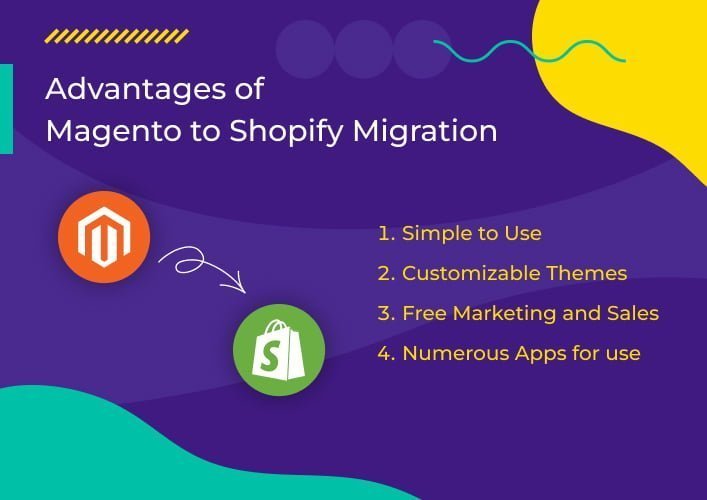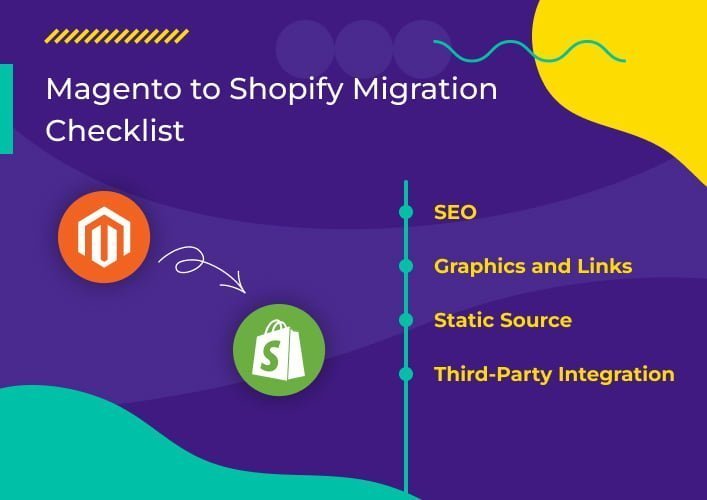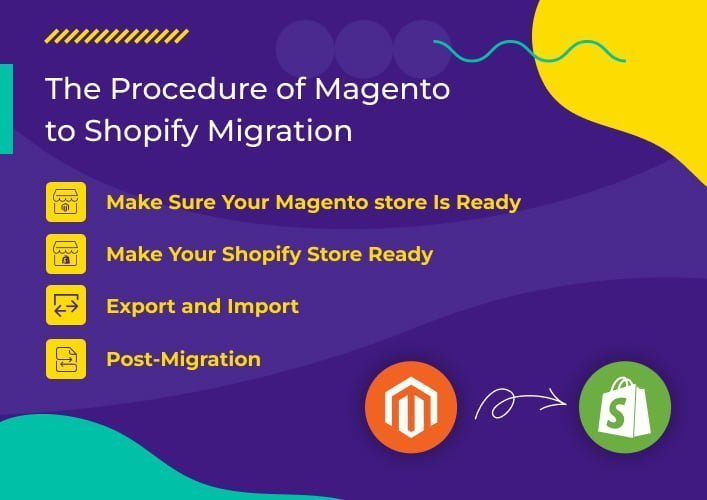Advantages of Magento to Shopify Migration

There are millions of Merchants from 175 Countries on Shopify. This is because of the advantages of Shopify over other e-commerce platforms. These are:
Simple to Use
You don’t need any technical expertise in setting up a Shopify Store. From store displays to updating the menus, everything is easy and straightforward. But, Magento is not user-friendly for those without technical expertise. It’s not easy to achieve eCommerce goals without coding expertise on such a powerful platform.
Customizable Themes
There is an extensive range of free themes available on Shopify. Furthermore, you don’t need to code to customize those themes. You can easily select the theme that reflects your brand. On the other hand, you need to contact a Magento developer in order to customize themes on Magento.
Free Marketing and Sales
Shopify has a number of built-in sales and advertising options that may help you expand your business. But in Magento, you need to install paid extensions to fulfill your sales and marketing requirements.
Numerous Apps for use
The Shopify App Store is a great resource for adding a wide variety of new functionalities to your e-commerce site. It comes loaded with hundreds of apps that may help you launch, expand, and manage your online store. On the other hand, Magento has both free & paid applications. But, unless you’re a developer, you won’t have nearly as much freedom to extend Magento’s capabilities without knowing how to code.
Thus, Shopify can be the perfect choice for the below-mentioned businesses:
- Non-Tech founders : If you are a non-tech person and want to build e-commerce, Shopify is the best choice for you because you don’t need to code.
- Small Business : Small companies often go toward Shopify as a means of getting a low-cost start off the ground because of the platform’s fair prices.
- Growing Business : If your business is in a growing phase, Shopify is a wise choice. It will help you expand your business.
- Large Business : Shopify is an excellent platform for digitally extending the reach of a well-established business.
Magento to Shopify Migration Checklist

To avoid losing conversions, visitors, and customer trust during a migration, it’s important to move not only data but also other factors. Let’s have a look at them.
- SEO : Organic traffic is what you want, and SEO is what gets it for you. Hence, if you want your search engine rankings and traffic to remain unchanged throughout the migration, you must implement 301 redirects from old site pages to your new Shopify store pages.
- Graphics and Links : Graphics from non-database sites such as category pages, blog posts, descriptions, and so on quickly disappear. We also have links to such images and content. Thus, pictures must be transferred to a selected site, and their current URLs must be changed.
- Static Source : Static source code is converted into automated code in Shopify. This allows you to avoid transferring code manually.
- Third-Party Integration : By integrating and automating processes, you may lower your business’s operating expenses. It may be hard to handle orders, manage accounts, or create marketing strategies if you don’t include them while migrating.
The procedure of Magento to Shopify Migration

Let’s take a closer look at the steps involved. After you have decided on a migration strategy, you may go on to the following phase.
Make Sure Your Magento store Is Ready
Do a complete data audit of your Magento store in advance of the migration. Verify that your Magento database has accurate information. Furthermore, choose which records need to be updated or removed.
Make Your Shopify Store Ready
The next step is to set up your Shopify Store. First, create an account on Shopify.com. You should stick with the default Shopify theme at this point and refrain from making any changes. You’ll have time to do changes to the theme afterwards. The transfer process might be affected by any customizations made at this time. Furthermore, add the required apps and features.
Export and Import
Try exporting data from Magento. In the Admin section, go to ‘System’, then select ‘Data Transfer’ and then ‘Export’. Set the Entity type, Format and continue to export data. After exporting data, get an import app. There are several applications available in the Shopify App Store that facilitate a smooth data migration. My app recommendation for Magento to Shopify migration is Store Importer, Ablestar Bulk Product and Multichannel Importer. Upload the exported files in any one of the apps.
Post-Migration
Firstly, verify the website transfer went well. Create a dummy product and place an order to ensure a smooth buying experience. Then, go through the checkout process by choosing your preferred delivery method and payment type. Furthermore, get the most out of your new business by taking use of the plethora of Shopify applications available. Additionally, you can now make your Shopify store seem exactly as you want it to by customizing themes. Lastly, inform your clientele that your business has moved to a new server and request that they login again.
Conclusion
It’s preferable to work with a technical migration service provider. Hire Shopify developers who help you in Magento to Shopify migration. They will be in a position to evaluate the kind of data you must transfer, implement any necessary adaptations or integrations, and craft the ideal migration strategy by using appropriate technologies.
FAQs
What is Magento to shopify migration checklist?
Which company provides Magento to shopify migration service?
Expert Shopify developers at Alian Software provide Magento to Shopify migration service at comparably low-cost hourly rates.
Why migrate from Magento to Shopify?
How do I import a product from Magento to Shopify?
How long does it take to migrate from Magento to Shopify?
Ravi Bhojani is the Chief Marketing Officer (CMO) at Alian Software, where he spearheads the company’s marketing strategies and drives its brand presence in the competitive IT services landscape. With over a decade of experience in the technology and marketing sectors, Ravi has consistently demonstrated his ability to blend innovative marketing techniques with deep industry knowledge to deliver outstanding results.